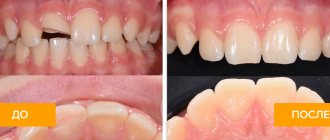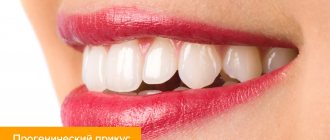Flux on the gums is an extremely unpleasant, but quite common phenomenon, which is an inflammatory process in the periosteum area. The word “flux” is of German origin and is translated as “flow, flow.” Today, this term is not commonly used in professional circles. Instead, experts use the scientific name of the disease - odontogenic periostitis. In most cases, it overtakes the most patient patients who diligently avoid visiting a professional dentist for a long time. As a result, due to laziness or fear of the dentist, the patient receives severe swelling of the gums, constant dull pain, and in some cases, high fever.
Despite the fact that the phenomenon in question cannot be called a rarity, this does not make it any less harmless. The advanced form of periostitis is quite dangerous, so the health of the oral cavity and teeth should be taken as seriously as possible, and at the first signs of inflammation you should consult a specialist as soon as possible.
Causes of the disease
Patients often blame the careless work of dentists for the development of inflammatory processes in the oral cavity. Thus, “flux after wisdom tooth removal” is one of the most discussed topics on dental forums. In fact, the most common causes of periostitis are gum trauma and untreated tooth decay. Often the situation is complicated by the patient’s reluctance to visit the dentist in a timely manner. As a result, food debris inevitably accumulates in places of damage, which eventually begin to rot. Further, the pus accumulates and then begins to rapidly spread, affecting healthy tissues of the oral cavity.
The most common causes of gumboil are damage to the gums, poor oral hygiene and caries.
Treatment of flux on the gums with folk remedies cannot guarantee a high-quality result. Most often, self-prepared medicinal products can only suppress the pronounced manifestations of the disease, and not eliminate the causes of its occurrence. For this reason, when the first symptoms of periostitis appear, it is important to undergo high-quality flux treatment in dentistry, which can guarantee complete relief of the inflammatory process.
What is flux
Flux is a somewhat outdated name that is common only in everyday communication. In modern dentistry, this pathology is called periostitis, which reflects the essence of the disease.
Periostitis is a purulent inflammation of the periosteum that covers the bone of the upper or lower jaw. As the pathological process develops, the lesion ceases to be local in nature and spreads to other tissues - an abscess appears on the surface of the gum.
Symptoms of gumboil
Symptoms are expressed in the appearance of a purulent sac or thickening of the gum area. The photo shows a clear example of gumboil on the gum. It is this infiltrate that is the main sign of the development of the disease. Experts distinguish two main forms of periostitis:
- The acute form is accompanied by severe toothache, severe tissue swelling, and swelling of the cheek. As the disease develops in the lower jaw, inflammation of the lymph nodes and swelling of the chin may occur. Often the advanced form of the disease causes elevated body temperature.
- The chronic form of the disease proceeds slowly and imperceptibly, which is its insidiousness. Often there is thickening of the jaw bone in the affected area. Despite the fact that there are practically no pronounced symptoms in this case, the consequences of this form of flux are no less dangerous.
What is periostitis and how does it manifest in children?
The disease is usually a consequence of advanced dental problems, when inflammation descends, spreading to the bone. In children, this process can happen very quickly - sometimes the hours count.
In everyday life, periostitis of the jaw is called gumboil
. It is usually acute in nature and manifests itself with the following symptoms:
- complaints of jaw pain;
- asymmetrical swelling, puffy cheek;
- enlarged lymph nodes in this area;
- increase in general body temperature;
- weakness of the child, signs of general intoxication.
Please note that with periostitis, cooling the inflamed area reduces pain, and heating
increases discomfort.
Look at photos of children with periostitis - you will notice that the face is asymmetrical, the cheek or cheekbone area is swollen and looks painful.
The symptoms listed above (one or more) should be a guide to immediate action - it is necessary to urgently take the child to the dentist. It should be noted that in this case a prior appointment is not required - at the municipal clinic you will be seen immediately with a note of “acute pain”.
Diagnostics
Before proceeding with dental flux treatment, the doctor must conduct an appropriate diagnostic examination. The exact diagnosis is determined based on data obtained during a clinical examination and x-ray diagnosis. Laboratory tests allow you to accurately determine the stage of the inflammatory process. Only after making an accurate diagnosis will a specialist be able to decide what to do with gumboil and which method of treatment in this particular case will be optimal.
Wisdom tooth removal
Typically, wisdom teeth appear at the age of 20 or older, but in some cases it is recommended to remove their buds. There are the following reasons for the removal of wisdom teeth in children:
- displacement of the follicle of the third molar;
- prerequisites for malocclusion;
- lack of space for wisdom teeth.
A specialist can recommend removal of a child’s wisdom teeth only after a thorough examination and consultation with other specialized doctors. You must first determine what position the molar is in and what place it will later occupy in the jaw.
How to treat flux?
If your tooth hurts and gumboil appears on your cheek, you shouldn’t panic and look for something to rinse your mouth with. “Grandmother’s” treatment methods really help get rid of acute pain and relieve some swelling, but they have not yet helped anyone cope with purulent compaction, which is the main danger. How and with what to treat flux? How to remove gumboil in case of gum inflammation? Only a qualified dentist can give detailed answers to these and other questions.
Self-medication with folk remedies will only help dull the pain and relieve swelling a little. Only a qualified dentist can completely remove pus and eliminate the cause of inflammation.
How is flux treated in dentistry? Currently, there are two main methods of treating gumboil on the cheek:
- Opening the pus sac, in which the doctor removes the accumulated pus through a small incision. The procedure is performed under anesthesia. After removing the pus, the specialist installs a drainage at the site of the incision - a special rubber strip that ensures the outflow of pus and prevents the wound from healing ahead of time.
- Cleaning an abscess through a root canal is necessary if the inflammation is a consequence of caries or a crack in the tooth.
Often in advanced stages of the disease there is a need for tooth extraction. Typically, this procedure is carried out when there is deep destruction of the causative tooth or if there is a large infected area between the tooth and the gum. Removal is also used if there is a sufficiently large crack in the tooth that cannot be treated.
Typically, the doctor begins by making an incision into the periosteum or lining of the mouth. The causative tooth is usually removed gradually, that is, in parts. For this, a special dental saw or laser is used. Modern equipment has made it possible to make the procedure for tooth extraction quick and completely painless, so there is no need to be afraid of treatment. After the operation, the sharp edges of the incision are smoothed, which is then washed with peroxide or other antiseptic agents and fixed with sutures.
Where does the abscess come from and what is its danger?
In the vast majority of cases, an abscess on the gum is associated with a tooth, often with a milk tooth. The most amazing thing is that the tooth may appear healthy from the outside, it may have a beautiful filling, and the tooth may not hurt. Why does pus still appear?
Baby teeth are less resistant to infection than permanent teeth; they are designed for a short service life, although they, like permanent teeth, have a nerve and roots. However, the roots of baby teeth begin to dissolve after five years. Caries in such teeth spreads much faster. Within three months, a cavity can form in the tooth, reaching the nerve. If caries is not treated, all pathogenic bacteria enter the dental nerve, and then, through the nerve, the microbes enter the bone. Bone is quite comfortable for microbes. They multiply there, dissolve the bone, which is accompanied by the formation of pus. If the tooth is open, there is a hole in it, pus comes out into the oral cavity. If food particles, fragments of destroyed enamel get into the tooth, or the tooth is covered with a filling without adequate treatment, pus can no longer flow freely. If the pus cannot flow out through the tooth cavity, it begins to look for another way out. The pus melts the bone and comes out under the gum. The outer covering of the gum, under which the pus has come out, swells and takes the form of a lump. Over time, the lump may burst and pus leaks out.
Once the pus is released, the lump may disappear and the gums may heal until the pus collects in large quantities again. The danger of such “bumps” is as follows:
- there is always an infection in the body (you should never forget that the abscess is not just on the gum, but in the head);
- the pus that is in the jaw dissolves the bone and can damage the growing permanent tooth.
The disappearance of an abscess next to a tooth never means recovery.
Symptoms that appear along with an abscess
- redness on the gum;
- tooth pain (optional);
- There is a hole in the tooth or there may be a filling on it;
- enlarged lymph nodes (dense “balls” appear under the lower jaw).
Sometimes a lump is discovered by chance, and the child may not be bothered by anything at all. The parent should periodically examine the child's mouth independently.
Antibiotics for flux
As noted above, flux is a consequence of a bacterial infection, which is often treated by taking antibiotics. Many, at their own peril and risk, try to cope with inflammation by independently taking quite strong medications that can cause serious damage to the health of the entire body. Effective and at the same time safe treatment of flux with antibiotics can only be prescribed by a qualified specialist.
Antibiotics for flux are prescribed by a doctor individually. Self-use of strong medications is fraught with serious consequences for the entire body.
Antibiotics, like anti-inflammatory drugs, are used in dentistry for flux as part of complex maintenance therapy. The only way to stop the inflammatory process and remove the pus is surgery. Antibiotics are usually prescribed at the very beginning of treatment if the disease is in the earliest stages of its development, but identifying such inflammation at the initial stage can be quite difficult. As a rule, the dentist is able to detect the very first signs of periostitis by accident, for example, during a routine examination of the oral cavity. The specialist prescribes antibiotics for flux individually, depending on the characteristics of the patient’s body and the general clinical picture.
Treatment
Treatment of flux in children should be carried out strictly under the supervision of a doctor. At the same time, treatment tactics for a one-year-old baby and a 7-year-old child may differ due to the fact that before the natural change of the primary bite, it is possible to remove a temporary tooth, which is extremely undesirable before the age of 5-6 years.
In such cases, it is rarely possible to do without surgery. Quite often it is necessary to resort to a surgical method of treatment - opening the flux with complete removal of all purulent masses and drainage of the resulting cavity. This allows you to both relieve acute pain and prevent the re-formation of gumboil.
But surgical treatment is one of the stages of therapy. After visiting the dentist, the child’s parents should continue treatment at home, which will include taking an antibiotic prescribed by a doctor, rinsing the mouth with antiseptic solutions and using traditional medicine.
Treatment at home
In the first few days after visiting the dentist, when pain may still bother the baby, it is necessary to take anti-inflammatory drugs (paracetamol, ibufen), which help both relieve pain and help the inflammatory process subside as quickly as possible.
An important point in home treatment is the use of antiseptic solutions for treating the oral cavity. The dentist will tell you what exactly to rinse the child’s mouth with, but we will only present possible treatment options that can be used even in a small child.
- Aqueous solution of chlorhexidine. A ready-made pharmaceutical preparation is used, which is used to rinse the mouth 3-4 times a day (after meals and before bedtime). It has a powerful antiseptic effect, but does not irritate the mucous membranes of the mouth.
- Furacillin solution. You can prepare it at home (1 tablet per 0.5 liters of water) or buy a ready-made product. Rinse your mouth up to 5 times a day (it is advisable to do this after eating).
- Miramistin is destructive to microorganisms and relieves inflammation well. It is recommended to rinse your mouth with 10 ml of solution 3-4 times a day. However, the drug cannot be used before the age of three.
A child should rinse his mouth with any of the above products strictly under the supervision of adults in order to avoid accidents. The course of treatment should continue until all manifestations completely subside and the purulent cavity heals.
Treatment with folk remedies
Traditional medicine recipes complement traditional treatment well. However, you need to be careful with such methods in very young children, and for treating children under 2 years of age it is better not to use them at all.
- Soda solution. This remedy has a good anti-inflammatory effect. A teaspoon of dry baking soda powder is dissolved in a large cup of warm boiled water and allowed to rinse the child’s mouth 3-4 times a day after eating. The effect of treatment can be enhanced with iodine by adding a few drops to the rinse solution.
- Propolis tincture also perfectly relieves inflammation and has an antiseptic effect. To treat the oral cavity, dissolve 5 drops of tincture in 200 ml of warm water and rinse the mouth 2-3 times a day.
- Herbal decoctions. Medicinal plants such as chamomile, calendula, and string are natural antiseptics and quickly relieve even severe inflammation. They allow both to cure the disease itself and to prevent the development of its complications. Decoctions are prepared daily, for which 2 tablespoons of a mixture of herbs are infused in half a liter of boiling water. Rinse your mouth with the resulting decoctions 4-5 times a day until complete recovery.
Homeopathy treatment
Homeopathic medicines can also be used in addition to primary treatment. You cannot try to cure gumboil in a child using homeopathy alone, since such remedies only play a supporting role. All prescriptions should be made only by a homeopathic doctor.
Flux - treatment in children
If a child has flux, you should never give him medications on your own, and especially antibiotics. Only a dentist can prescribe a medicinal course of treatment. Antibiotics destroy both pathogenic and beneficial bacteria that help fight infection, so the unauthorized use of such serious drugs can lead to negative consequences for the child’s entire body.
Treatment of gumboil largely depends on the causes of its occurrence. So, this process is not much different from the treatment of periostitis in adult patients. As a rule, to begin with, the specialist makes a small incision in the area of the inflammation and ensures the outflow of pus using a special drainage system. The treatment then continues at home under the supervision of parents. Most often, a complex of medications is prescribed, but in some cases, a specialist may allow you to limit yourself to rinsing with special decoctions and solutions.
Treatment of flux in a child at the CIS
At the Center of Israeli Dentistry on the Left Bank of Kyiv, a team of pediatric dentists performs the full range of treatment measures for diseases of the teeth, gums and oral cavity. We have a special approach to small patients that allows us to get rid of fears and anxiety before medical procedures.
When treating flux in a child, the first thing the doctor does is diagnose it. This includes an examination of the oral cavity, interviews with parents and the child, and an x-ray examination. An x-ray shows the extent of damage to teeth and tissues. Only after diagnostic procedures does the doctor decide on the patient’s treatment tactics.
Flux on the gums: surgical treatment
Flux in children and adults is mainly treated surgically, like all purulent formations. The abscess needs to be opened and the wound cleaned. Surgical operation to remove flux consists of the following steps:
- Pain relief . First of all, the doctor administers local anesthesia so that the child does not feel pain or discomfort.
- Removing flux . After administering the anesthetic, an incision is made with a scalpel. The doctor removes the pus, after which a drainage is placed - a small rubber strip. This is necessary so that the wound does not heal prematurely, since within 3-4 days the remains of purulent masses still flow out of the wound.
- Tooth extraction . Typically, teeth in the area of purulent lesions should be removed. Removal of teeth due to gumboil is practiced more often in pediatric dentistry, since children's milk teeth will be replaced by permanent teeth. In some cases, the doctor decides to save a baby tooth if this will have a positive effect on the formation of the child’s bite.
Flux on a child’s gums: what to do after surgery
Therapeutic measures for flux are not limited to surgical intervention. No less important is the postoperative period, during which the small patient is prescribed antibiotics and antiseptics for rinsing the mouth. Even if the child feels well, be sure to take the prescribed medications, adhering to the dosage and regimen.
These treatment measures usually end successfully. Symptoms that bother a child with flux disappear (fever, pain). Within a few weeks, the lump also resolves, since there is no longer an abscess in it.
How not to cause harm?
What to do if flux appears? Some patients mistakenly believe that swelling and severe toothache can be relieved on their own with the help of warming compresses, herbal infusions and other folk remedies. Unfortunately, such health experiments often end very badly. Thus, in order not to inadvertently harm yourself and provoke further development of the disease, the following contraindications should be observed:
- No warming compresses that contribute to the spread of periostitis.
- Never take painkillers less than 3 hours before visiting the dentist. Otherwise, you can significantly complicate the diagnosis process.
- After opening a purulent lesion, you should not take aspirin. It can provoke bleeding, especially since it is completely useless as a pain reliever in this case.
- If your condition has not improved 12 hours after surgery, you should see your doctor again.
Abscess on the gum of a child: treatment
Thus, if a lump or fistula appears on a child’s gum, you should immediately go to the dentist. The strategy for temporary and permanent teeth in this case will be very different, and below we will describe in detail when such teeth can be treated and when they must be removed. If you find it difficult and cannot decide if it is a temporary or permanent tooth, use the tables with the timing of teething in primary and permanent dentition in children.
What to do after removal or opening?
After opening the flux, you should not wait for the swelling to disappear immediately. Many patients feel that the flux does not go away after tooth extraction, although this is not the case at all. In some cases, the swelling may increase slightly after the procedure. Approximately on the third day after surgery, the patient should make a dramatic recovery, but the infiltration may remain for quite a long time. Within a few hours after the operation, the toothache in the area of the lesion should disappear and the body temperature should decrease.
Usually the swelling goes away only a few days after opening the purulent focus. Do not be alarmed if the swelling increases slightly after surgery.
The specialist installs a special rubber drainage in the incision, which you should never try to fix yourself. Otherwise, the recommendations are the same as for regular tooth extraction. You should not eat for several hours after the procedure. During the day, try to avoid hard and rough foods, as well as hot drinks. Regarding the use of medications in each individual case, the specialist gives individual recommendations.
Possible complications
Very often, parents underestimate the seriousness of such a disease as gumboil in children. However, this pathology is fraught with extremely serious complications that can even threaten the baby’s life.
- An abscess is the formation of a large purulent focus, the boundaries of which extend beyond the periosteum. Sometimes such ulcers can break out in the gum or even cheek area, forming fistulas from which pus constantly flows.
- Cellulitis is the spread of purulent inflammation to adjacent anatomical areas. The most severe consequence of flux, in which there is a very high risk of developing sepsis - blood poisoning, often leading to death.
- Death of the rudiments of permanent teeth, leading to adentia. Severe inflammation within the gums can spread to the area of the permanent tooth bud and cause damage or death. As a result, when changing the primary dentition, the eruption of molars will not occur, which will require prosthetics at a young age.
It is not difficult to suspect the development of complications. Usually, with treatment after opening the flux, the symptoms quickly begin to subside. After a few hours, the child’s temperature decreases, swelling decreases, and the incision site practically does not hurt. But if the fever does not go away, and the pain only increases, then this is a reason to seek emergency medical help again, because Most likely there are inflammatory complications.
Treatment prices
The cost of flux treatment largely depends on the severity and severity of the disease, as well as on the method of therapy chosen by the specialist. It is worth noting that modern medicine offers all the possibilities for quick, effective and completely painless elimination of the causes and consequences of periostitis. In addition, the price for flux treatment is influenced by factors such as the level of prestige of the dental clinic, the cost of the equipment and materials used, and the level of qualifications of the practitioners.
If the causative tooth is still a baby tooth -
When writing this section, we used the “National Guide to Pediatric Therapeutic Dentistry” (edited by Professor V.K. Leontyev). Let's figure out what parents need to know... The presence of a swelling/bump on the gum, or a fistula, indicates the development of acute periodontitis, or an exacerbation of chronic periodontitis. In the vast majority of cases, baby teeth that have caused the appearance of ulcers on the gums must be subject to mandatory removal. The fact is that in most cases the roots of baby teeth will either not yet be formed or will already have signs of resorption (see photo below).
In both cases, this will not allow for high-quality obturation (filling) of the root canal lumen with filling material. Poor quality filling will certainly lead to the development of purulent inflammation, and in severe cases, sepsis, which even poses a threat to life. Injury to the permanent tooth germ is also possible, both during root canal treatment and as a result of the development of purulent inflammation in the area of the apex of the roots of a baby tooth.
Milk teeth for removal (with signs of resorption) –
But the physiological immaturity of the immune system of children also poses a problem for the treatment of such teeth, which in this situation also contributes to the development of purulent complications. Therefore, to determine the possibility of treatment, we first need a targeted Rg image, which will show the degree of resorption, as well as the presence of foci of inflammation at the apex of the roots of a baby tooth. Below we will list when such teeth require mandatory removal, and in what situations you can try endodontic root canal treatment in baby teeth.
Indications for mandatory removal:
- if there are less than 2 years left before the physiological change,
- if the tooth crown is severely damaged and cannot be restored,
- the tooth has degree II-III mobility,
- in the presence of a fistula tract,
- if the x-ray shows signs of root resorption (we are talking not only about external root resorption, but also about internal one),
- if the image shows a pronounced inflammatory focus of bone tissue destruction (at the apex of the root of a baby tooth), i.e. we are talking about an exacerbation of chronic granulating periodontitis,
- if the child belongs to health groups III, IV, V,
- if the child has caries in the area of most teeth (decompensated form of the carious process).
Possibility of endodontic treatment:
- if the root of the baby tooth is formed and does not show signs of resorption,
- in the absence of tooth mobility,
- in the absence of a fistula tract,
- if the focus of inflammatory destruction at the apex of the root of a baby tooth is very small in size, and at the same time is separated from the permanent tooth germ by a layer of unchanged bone tissue. Filling the canals of a baby tooth (before and after photos) –
Important: you should also take into account that such treatment is very complex and requires a highly qualified pediatric dentist, as well as a large amount of time per patient. Therefore, this is unlikely to be a good idea – if we are talking about public medicine. Also, endodontic treatment will require several visits, and subsequently regular follow-up with radiography (parents must be prepared for this). You also need to consider how important this tooth is in terms of preventing malocclusion.
Filling canals in a baby tooth (video):
In the video below you can see the process of filling root canals in the 1st primary molar. Please note that mechanical treatment of root canals was performed using an endodontic tip and modern rotary files (created specifically for children's teeth). The most modern paste based on calcium hydroxide and iodoform was used as a material for filling root canals in baby teeth. At the end of the video, you will be able to see an x-ray that shows the quality of root canal filling. In this case, I would like to say about the excellent work of the doctor.
A few more things parents should know:
Unfortunately, in recent years, due to the deterioration in the quality of training of doctors, you can hear that many pediatric dentists recommend not removing such teeth, citing the fact that removal will cause malocclusion. And therefore, very often children continue to walk with chronic inflammation at the roots of their baby teeth. In part, the effect of early removal of baby teeth on the bite is true (but primarily only in relation to baby molars, the removal of which can lead to a shift in the rudiments of permanent teeth). But this is not the only thing to consider.
The fact is that the purulent focus of inflammation in the area of the roots of a baby tooth is separated from the permanent tooth germ by only 1-2 mm of bone (Fig. 6). Studies have shown that disruption of the eruption of permanent teeth is caused not only by the early removal of baby teeth, but also by the influence of pyogenic bacteria and their toxins on the rudiments of permanent teeth. For example, you did not remove a child’s baby tooth with inflammation at the apex of the root, and this will also delay the eruption of a permanent tooth. In addition, inflammation at the root of a baby tooth can even lead to the death of a permanent tooth germ (this happens especially often if inflammation occurs before the start of mineralization processes in the permanent tooth germ).
Important: you also need to take into account the effect of a pyogenic infection on the general health of the child. For example, the fact that infection from the source of inflammation will constantly enter the submandibular lymph nodes, causing the development of lymphadenitis. In addition, once in the blood, waste products of pyogenic bacteria affect the entire body as a whole - they increase the risk of developing allergies, bronchial asthma, diabetes, heart and joint diseases.
If purulent inflammation is accompanied by the formation of a fistula, then you must understand that pus will constantly enter the oral cavity through the fistula, the child will swallow it, and this will lead to the colonization of the tonsils with a pyogenic infection and the development of chronic tonsillitis. And in this case, the development of a sore throat or constant regular exacerbations of chronic tonsillitis is guaranteed for the child.









